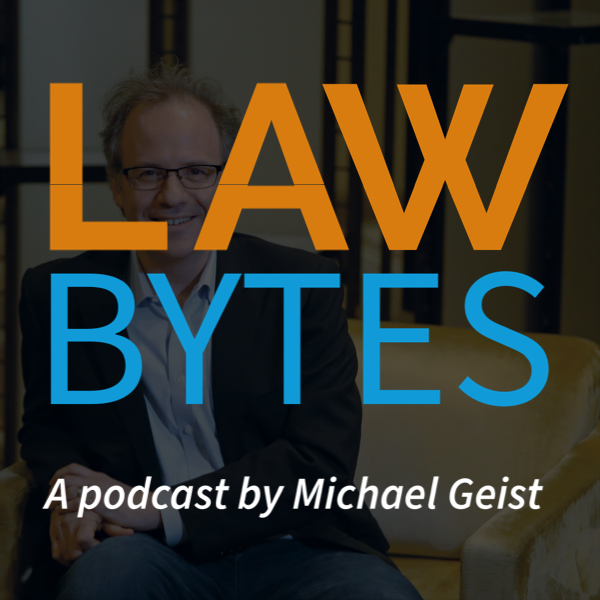The Montreal Gazette features a series of MP3 recordings of an interview with Bell's Mirko Bibic on the throttling issue.
Bell Responds to Throttling Concerns
April 15, 2008
Share this post
4 Comments

Law Bytes
Episode 231: Sara Bannerman on How Canadian Political Parties Maximize Voter Data Collection and Minimize Privacy Safeguards
byMichael Geist

March 31, 2025
Michael Geist
March 24, 2025
Michael Geist
March 10, 2025
Michael Geist
Search Results placeholder
Recent Posts
 The Law Bytes Podcast, Episode 231: Sara Bannerman on How Canadian Political Parties Maximize Voter Data Collection and Minimize Privacy Safeguards
The Law Bytes Podcast, Episode 231: Sara Bannerman on How Canadian Political Parties Maximize Voter Data Collection and Minimize Privacy Safeguards  The Law Bytes Podcast, Episode 230: Aengus Bridgman on the 2025 Federal Election, Social Media Platforms, and Misinformation
The Law Bytes Podcast, Episode 230: Aengus Bridgman on the 2025 Federal Election, Social Media Platforms, and Misinformation  The Law Bytes Podcast, Episode 229: My Digital Access Day Keynote – Assessing the Canadian Digital Policy Record
The Law Bytes Podcast, Episode 229: My Digital Access Day Keynote – Assessing the Canadian Digital Policy Record  Queen’s University Trustees Reject Divestment Efforts Emphasizing the Importance of Institutional Neutrality
Queen’s University Trustees Reject Divestment Efforts Emphasizing the Importance of Institutional Neutrality  The Law Bytes Podcast, Episode 228: Kumanan Wilson on Why Canadian Health Data Requires Stronger Privacy Protection in the Trump Era
The Law Bytes Podcast, Episode 228: Kumanan Wilson on Why Canadian Health Data Requires Stronger Privacy Protection in the Trump Era

Feeling a little confused…
From the article:
\”What we\’re doing is trying to take objective measures. We\’re not targeting particular people or particular content, we\’re directing these measures at a particular type of traffic. It\’s not slowing down peer-to-peer for everyone. … It\’s actually the P2P by heavy users, whether or not they\’re on Sympatico or on the wholesale ISP. And at that, it\’s only during so-called peak periods. Those who use P2P to a reasonable degree are not affected.\”
They are \”directing these measures at a particular type of traffic\” but \”not slowing down peer-to-peer for everyone\”. Does this mean Bit Torrent is throttled but not something like Kazaa? He goes on to say \”it\’s actually the P2P by heavy users\” (all Bit Torrent users?)when just before that he said \”we\’re not targeting particular people\”. So what exactly are they throttling? Protocols (Bit Torrent?), traffic (P2P), or specific users that over-utilize their connection compared to the average user?
lies
I always find the claim that ‘95% of users do not use P2P applications’ confusing since literally 95% of the people I know use P2P on a regular basis including my parents who are in their late-50’s and not all that computer savy at all. Perhaps they are referring to 95% of the entire population of Canada, not just Bell DSL users 🙂
30 kilobits = 3.75 kilobytes
Bibic said in the interview that anybody that consumes more than 30 Kb (killobits) is a bandwidth hog. This is 3.75 killobytes.
You are paying $50 for dialup. $2.4bn in infrastructure investment? Shenanigans.
I’m am completely unsurprised by the findings of the World Economic Forum. I’m loathe to be within a continent of Bibic and Bell.
bandwidth is not constrained
The bandwidth between your house and the local DSL center might be a little constrained, but the bandwidth for the backbone is quite underused. Basically, as I understand it, a fiber based backbone’s bandwidth is primarily limited by the ability of the laser to turn off and on quickly, as well as the sensitivity of the receivers to multiple wavelengths are the same time.
Our backbone is currently fairly underused, and if it ever becomes a choke point, increasing it’s available bandwidth is easier and cheaper than increasing the bandwidth of every single dsl connection.
Another point of interest- there are ways to increase the efficiency of P2P applications quite significantly. Check out the work Comcast has been doing in the states. They’re calling it P4P I think… in any case, it uses the available bandwidth more efficiently by prioritizing geographically close connections.